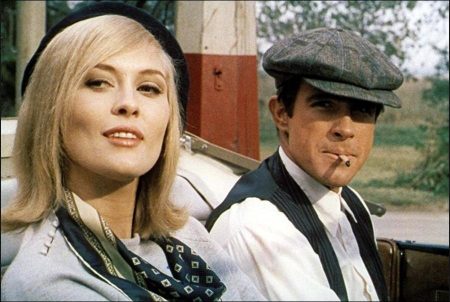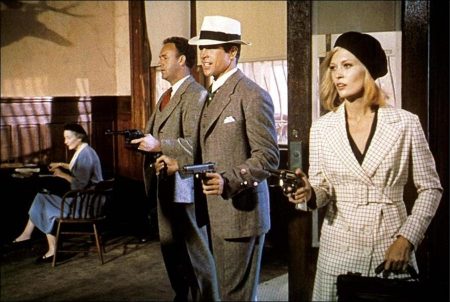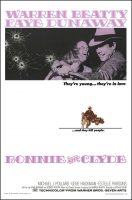Tagline: They’re young… they’re in love… and they kill people.
Young adults Bonnie Parker, a waitress, and Clyde Barrow, a criminal just released from prison, are immediately attracted to what the other represents for their life when they meet by chance in West Dallas, Texas. Bonnie is fascinated with Clyde’s criminal past, and his matter-of-factness and bravado in talking about it. Clyde sees in Bonnie someone sympatico to his goals in life. Although attracted to each other physically, a sexual relationship between the two has a few obstacles to happen.
Regardless, they decide to join forces to embark on a life of crime, holding up whatever establishments, primarily banks, to make money and to have fun. They don’t plan on hurting anyone physically or killing anyone despite wielding loaded guns. They amass a small gang of willing accomplices, including C.W. Moss, a mechanic to fix whatever cars they steal which is important especially for their getaways, and Buck Barrow, one of Clyde’s older brothers. The only reluctant tag-along is Buck’s nervous wife, Blanche Barrow, a preacher’s daughter.
The gang’s life changes after the first fatal shot is fired. Following, their willingness to shoot to kill increases to protect themselves and their livelihood. Their notoriety precedes them, so much so that no matter what one’s opinion is of them, most want to have some association to the Barrow gang, to help them, to be spoken in the same breath as them, or to capture and or kill them. Of the many people they encounter in their crime spree, the one who may have the most profound effect on their lives is Texas Ranger Frank Hamer, who is looking for a little retribution.
Bonnie and Clyde (1967) is one of the sixties’ most talked about, comedy volatile, controversial crime / gangster movies combined, terror, love and ferocious violence. It was produced by Warner Bros. – the studio responsible for the gangster films in the 1930s, and it seems appropriate that this innovation, the film romanticized revisionist and redefined the gangster genre crime / and the portrayal of violence in screen forever.
Its producer, 28, Warren Beatty, was also his role as star Clyde Barrow and his co-star Bonnie Parker, a newcomer Faye Dunaway became an actress because of her major breakthrough in this influential film. Similarly, unknown Gene Hackman has been recognized as a solid actor and then to play many important roles (his major role was in the French Connection (1971)).
The story of rise and fall of self-harm as Clyde gangster anti-authoritarian criminal is well documented. Both figures illustrate the tragic outlaw “innocent people on the go” who cling to each other and try to operate as a family. The film, with many conflicting moods and changes in tone (serious humor), is a cross between a gangster film, traditions and tragic romance, a road movie and the movie with friends, and screwball comedy. It illustrates several features of experimental film-making of the French New Wave (Nouvelle Vague) movement. [Originally the film was being directed by Jean-Luc Godard and Francois Truffaut, who withdrew and made Fahrenheit 451 (1966) instead.] Displays the main movie on the infamous couple romanticized violence and proclaimed: “They are young … they are in love … and they kill people.”
Bonnie and Clyde (1967)
Directed by: Arthur Penn
Starring: Warren Beatty, Faye Dunaway, Michael J. Pollard, Gene Hackman, Estelle Parsons, Denver Pyle, Dub Taylor, Evans Evans, Gene Wilder, Martha Adcock, Harry Appling, Patrick Cranshaw
Screenplay by: David Newman, Robert Benton
Production Design by:
Cinematography by: Burnett Guffey
Film Editing by: Dede Allen
Costume Design by: Theadora Van Runkle
Set Decoration by: Raymond Paul
Art Direction by: Dean Tavoularis
Music by: Charles Strouse
MPAA Rating: R for violence.
Distributed by: Warner Bros. Pictures
Release Date: August 13, 1967
Views: 194


